Forge+Bond 30 EM Wheels
Internal Width: 30 mm
Sizes Available: 29’’
Material: Carbon Fiber (FusionFiber Thermoplastic)
Stated weight:
- 30 EM Rim: 530 g
- 30 EM 28h Wheelset: 1,884 g
- 30 EM 32h Wheelset: 1,982 g
Blister’s Measured Weight (30 EM 28h wheelset, w/ pre-installed rim tape):
- Front: 856 g
- Rear: 1,008 g
- Total: 1,864 g
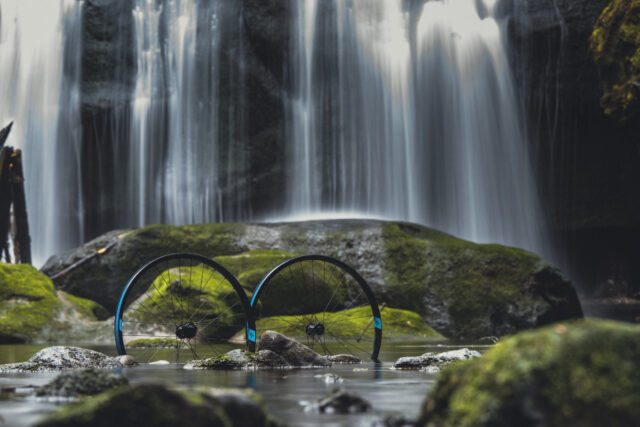
MSRP:
- Wheelset w/ Industry Nine 1/1 hubs: $1,899
- Wheelset w/ Industry Nine Hydra hubs: $2,199
Reviewer: 6’, 175 lb / 183 cm, 79.4 kg
Test Duration: 4.5 months
Test Locations: Washington, British Columbia
Bolted To: Transition Smuggler, Yeti SB160, BTR Ranger
Intro
Forge+Bond is a new company making carbon fiber wheels out of their facility in Utah, and while you presumably haven’t heard of Forge+Bond before (they’re launching today, after all), their parent company, CSS Composites might be familiar. That’s because CSS has been making wheels for Revel, Evil, and Chris King for a while now. Forge+Bond is the brand that they’re launching to continue their development efforts
Most of the carbon fiber bike parts that are out in the world use thermoset construction, but the Forge+Bond wheels are made with thermoplastic carbon construction — which Forge+Bond refers to as “FusionFiber.” And their first mountain bike wheels, the 30 EMs, are meant for all-around Trail and Enduro use.
[Forge+Bond is also launching a Gravel wheelset, dubbed the 25 GR, which uses similar construction just in a lighter, narrower package. We’re going to focus on the 30 EM MTB wheels here, but the high-level info about the construction applies to both.]
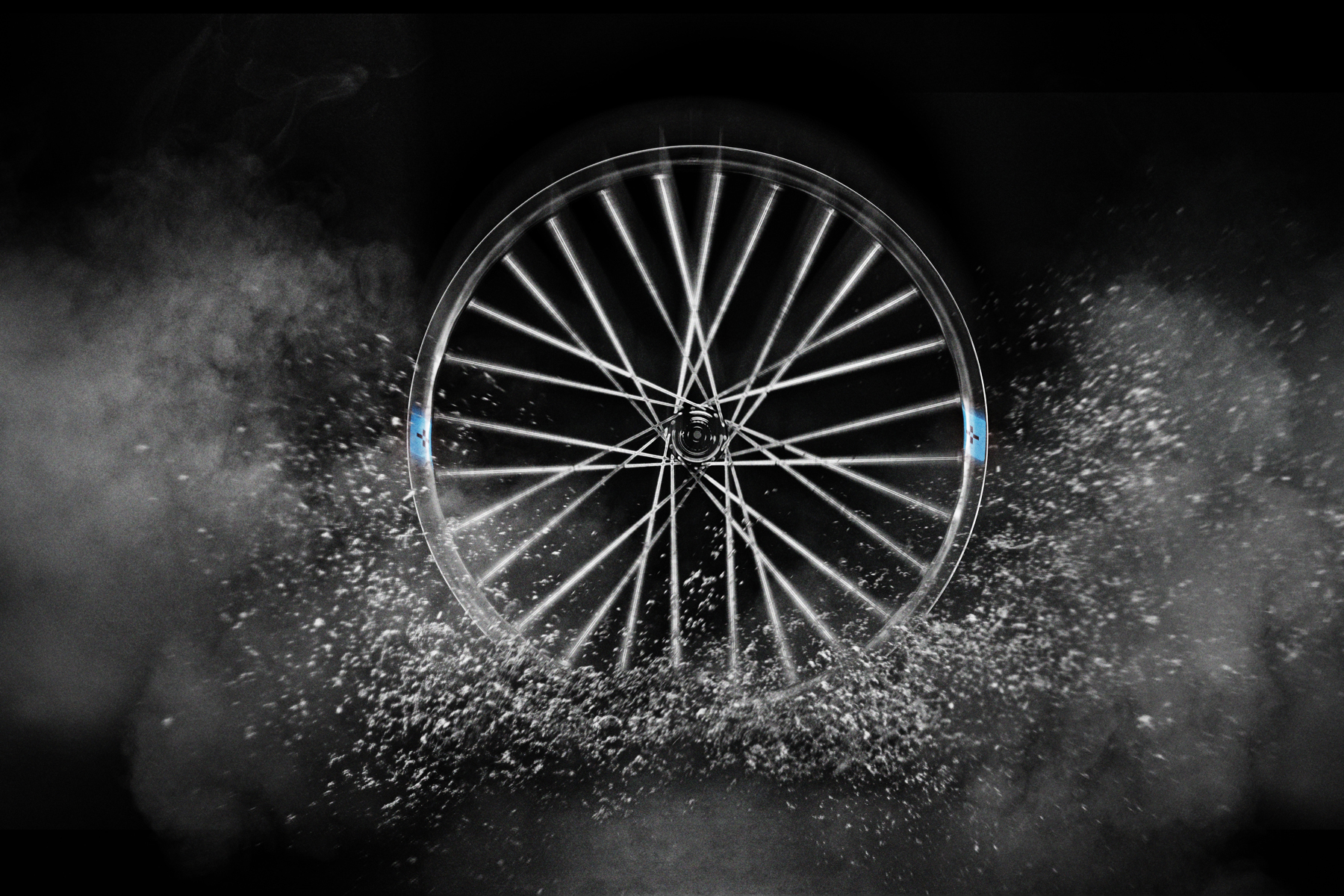
The Forge+Bond wheels aren’t the first thermoplastic wheels on the market, since Forge+Bond’s parent company, CSS Composites, has been making a variety of FusionFiber wheels for Revel, Evil, and Chris King (MTN30 review coming soon) for a while now. But Forge+Bond is describing the 30 EM wheels as the second generation of their FusionFiber wheels (though the versions that CSS makes for the aforementioned brands aren’t 100% identical to each other) and there’s some interesting stuff going on with their design.
Guerrilla Gravity has also been making thermoplastic carbon fiber frames for a while now — and we’ve talked with them about it on a few occasions, including Episodes 3 and 98 of Bikes & Big Ideas, but thermoplastic parts are still a rarity in the bike world. So what do we even mean by “thermoplastic” vs. “thermoset” and what has Forge+Bond done with the design of the 30 EMs? Let’s dive in.
Design
Before we get into the particulars of the 30 EM wheels, it’d probably be worth doing a quick overview of the high-level differences between thermoplastic and thermoset carbon fiber. If you don’t feel like getting a bit nerdy on the matter, feel free to skip down a few paragraphs.
In short, carbon fiber parts of either sort are comprised of two main components: the carbon fibers themselves and some form of “matrix” that holds them together, makes them rigid, and gives the part structure. Thermoset parts use epoxy for the matrix and undergo a chemical reaction in the curing process, whereby the epoxy solidifies; thermoplastic parts use a matrix that can be melted and re-solidified — theoretically infinitely — which, among other things, means that thermoplastic parts can be recycled.
The asterisk there is that recycling thermoplastic parts essentially entails grinding them up, then remelting the chewed-up bits and molding them into something else. That inevitably produces some degradation of the material since the carbon fiber strands are cut shorter, and you lose the ability to as carefully control fiber orientation in the recycled product — we’re a long way from making new rims out of recycled rims, for example. But it’s still a whole lot better than what’s possible with thermoset carbon parts, and Forge+Bond is showing off some tire levers made of recycled FusionFiber material as a starting point, and promising more things to come down the line.
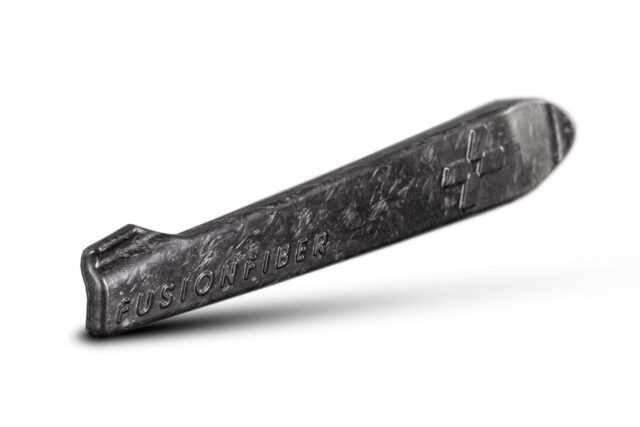
And Forge+Bond is taking its recycling efforts seriously. For one, they handle all warranty claims directly, rather than going through shops or other third parties, so that they can guarantee the collection of all broken rims for recycling. And they say that they’re able to collect essentially all of the scrap material generated from the production of the 30 EMs too — claiming that just a fraction of a percent goes unrecycled. The rims are said to need no sanding or deburring once they come out of the final mold, though some excess material needs to be trimmed off earlier in the process. Forge+Bond says that working with thermoplastic carbon fiber allows them to automate a great deal of the trimming and layup processes in ways that wouldn’t be viable in thermoset composites and that their raw materials also don’t need to be refrigerated for storage before curing (in contrast to thermoset composites, which need to stay cold to prevent them from curing on their own, and still have a finite shelf life even when stored properly).
Forge+Bond is pretty tight-lipped about the finer details of how the 30 EM rims differ from the ones that CSS has made for the likes of Revel, Evil, and Chris King. They do say that while the concept is similar, the 30 EM rims feature some changes in the materials and manufacturing techniques based on what they’ve learned from past projects — think of the 30 EMs as the second-generation of FusionFiber wheels if you like.
Unsurprisingly, given both their name and the state of the market, the 30 EM rims feature a 30 mm internal width (Forge+Bond recommends 2.3’’ to 2.6’’ tires), and have especially wide, 4mm-thick sidewalls to help stave off rim damage and pinch flats. They’re available with either 28- or 32-hole drilling, but only in 29’’ diameter for now — though Forge+Bond has hinted that a 27.5’’ version is in the works. For the time being, they’re only available as a complete wheelset with Industry Nine Hydra hubs, though Forge+Bond has also said that a rim-only configuration will be available from select retailers for custom builds.
[Update: Forge+Bond has slightly tweaked the 30 EM offerings since launch, and now offers the wheelsets with the 32-hole rear wheel, only, paired with your choice of a 28- or 32-hole front wheel. They’ve also added an Industry Nine 1/1 hub option, though the 27.5’’ version that they teased at launch hasn’t yet materialized.]
In addition to the recyclability and other sustainability benefits of thermoplastic carbon fiber, Forge+Bond says that it also has a real advantage over thermoset composites when it comes to damping properties in particular. Forge+Bond’s argument is essentially that the greater flexibility of their thermoplastic matrix material as compared to typical epoxy resins used in thermoset wheels (taking the carbon fibers themselves out of the equation for a moment) allows them to build wheels with more damping and that transmit less feedback to the rider, while also being stiff and precise in how they handle and hold a line.
The 30 EM rims also feature some interesting shaping that distributes additional material at the spoke holes where it’s needed for strength, and thins out between them to save weight; the rim sidewalls also feature some rippling to redistribute material where it’s needed, similar to what we’ve seen on a few different wheels from Nobl as well as the We Are One Convergence line, albeit in a more subtle fashion.
That means that the 28- and 32-hole versions of the rims get their own dedicated molds and layups, but Forge+Bond says that they’re essentially the same design, just reconfigured for different spoke counts. The 32-hole version should build into a stiffer, burlier wheel due to the extra spokes, but the rims themselves are very similar.
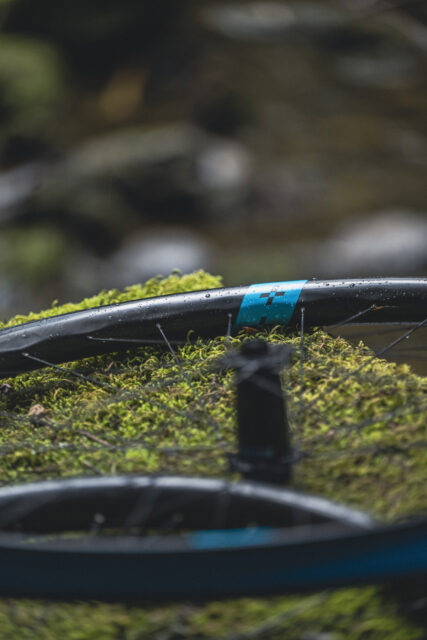
For the time being, Forge+Bond’s wheels are available directly from Forge+Bond in the US and Canada, with alternate distributors and wider global sales opening up sometime down the road.
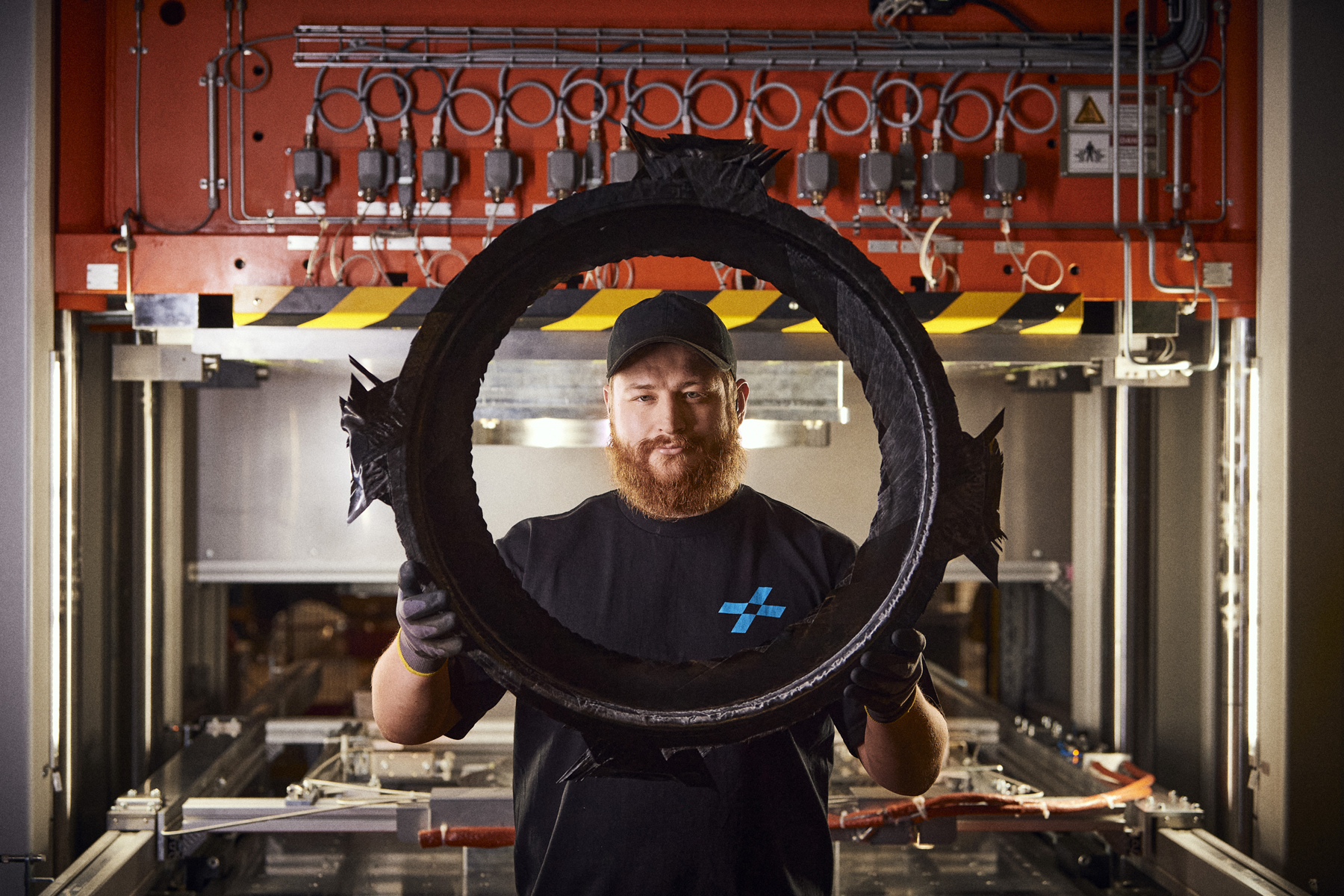
Weight (and Comparisons)
At a stated weight of 530 g per rim, the 30 EMs are a touch on the heavier side of average for an all-around carbon rim, but only by a few tens of grams. Below are the listed weights for a variety of rims in both the lightweight Trail and burlier Enduro categories, as well as complete wheelset weights for reference; the wheelset weights are all as measured by Blister unless otherwise noted.
Rims:
408 g Enve M630 (carbon)
395 g front / 435 g rear NOBL TR35 (carbon)
425 g We Are One Faction (carbon)
436 g Revel RW27 (carbon)
440 g Reserve 30|SL (carbon)
480 g Revel RW30 (carbon)
480 g Reserve 30|HD (carbon)
495 g We Are One Union (carbon)
500 g Reserve 30|SL AL (aluminum)
525 g DT Swiss XM 481 (aluminum)
525 g Race Face ARC30 (aluminum)
530 g Forge+Bond 30 EM (carbon)
570 g DT Swiss EX 511 (aluminum)
580 g Enve M730 (carbon)
580 g Reserve 30|HD AL (aluminum)
Wheelsets:
1,571 g NOBL TR35 + DT Swiss 240 EXP (carbon, measured)
1,576 g Reynolds Blacklabel 329 Trail Pro (carbon, measured)
1,639 g DT Swiss XMC 1501 (carbon, stated)
1,648 g Enve M630 + Industry Nine 1/1 (carbon, stated)
1,718 g Reserve 30|SL + Industry Nine 1/1 (carbon , measured)
1,740 g We Are One Faction + Industry Nine 1/1 (carbon, stated)
1,758 g Revel RW27 + Industry Nine 1/1 (carbon, stated)
1,803 g Chris King MTN30 (carbon, measured)
1,840 g Revel RW30 + Industry Nine Hydra (carbon, measured)
1,840 g Reserve 30|SL AL (aluminum, stated)
1,848 g DT Swiss XM 1700 (aluminum, stated)
1,849 g Santa Cruz Reserve 30|HD + Industry Nine Hydra (carbon, measured)
1,864 g Forge+Bond 30 EM 28h + Industry Nine Hydra (carbon, measured)
1,877 g We Are One Union + Industry Nine Hydra (carbon, 27.5’’ diameter, measured)
1,985 g DT Swiss EX 1700 (aluminum, stated)
2,069 g Enve M730 / Chris King (carbon, measured)
2,104 g Reserve 30|HD AL (aluminum, measured)
Some Questions / Things We’re Curious About
(1) Forge+Bond is making some big claims about the damping and ride quality of the 30 EM wheels, but are those borne out on trail?
(2) And how do the EM 30s compare to both other FusionFiber wheels from the likes of Revel and Chris King, as well as thermoset composite ones from a whole bunch of other brands, including Reserve and We Are One?
FULL REVIEW
CSS’s Fusion Fiber thermoplastic wheels aren’t new, but the Forge+Bond 30 EMs are, and Forge+Bond isn’t shy about their performance claims for the new offerings. But do the 30 EMs live up to those claims on the trail? We were curious to find out.
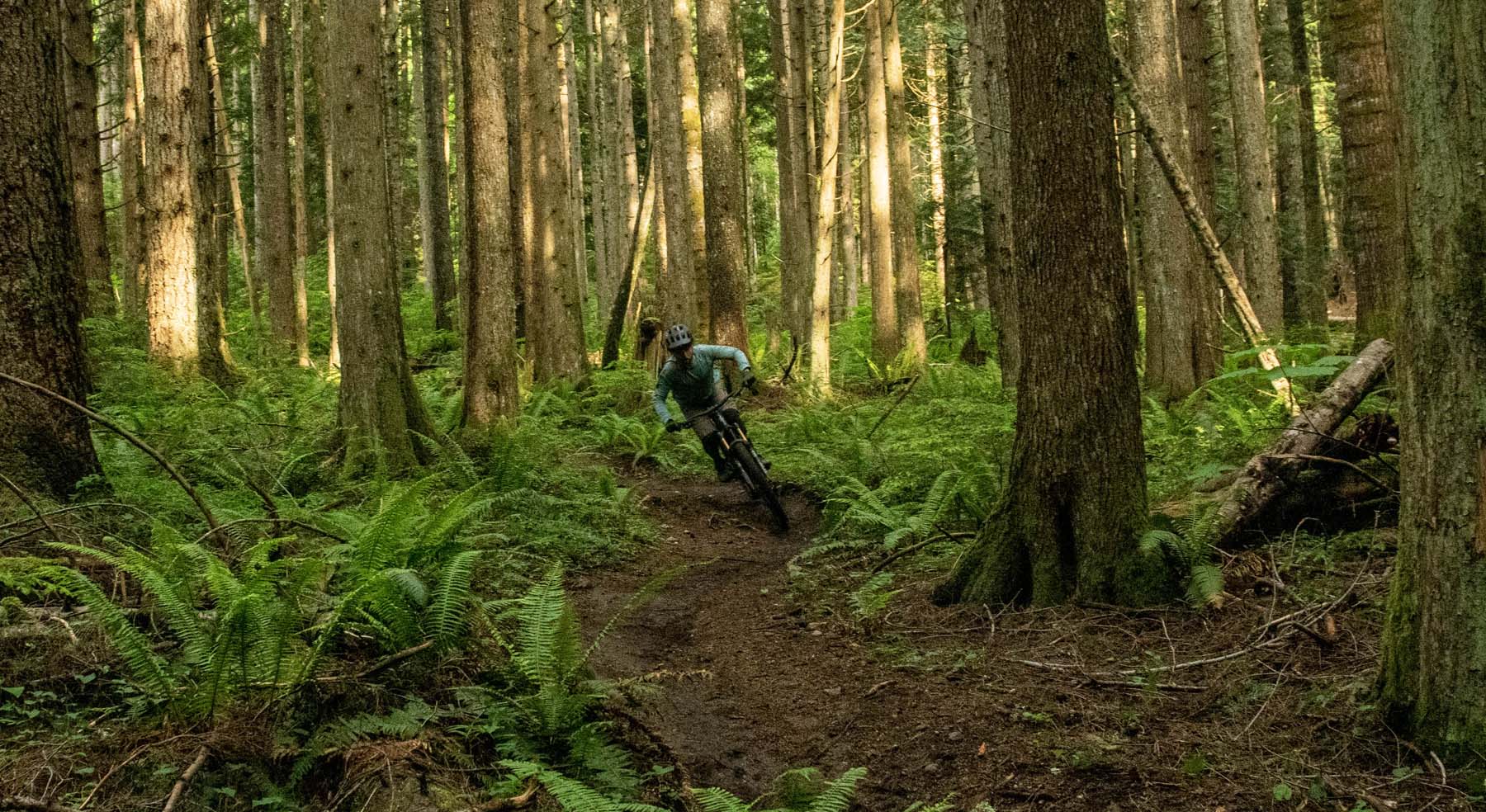
On the Trail
I’ve been riding the 28-hole version of the 30 EM wheels since the early spring, on a wide spectrum of bikes ranging from my personal hardtail up through the Yeti SB160, with the Transition Smuggler in between for good measure. I ran a few different tires over the course of testing, including Exo+ and DoubleDown casings from Maxxis, as well as Continental Kryptotal DHs, and all mounted and seated up without issue (or no more so than normal, anyway; the DH-casing Continentals tend to be tough to mount no matter the rim).
It is worth noting that Forge+Bond doesn’t sell this exact version of the 30 EMs anymore — with the launch of the lighter-duty 30 AM wheel (which we just got in for testing — more on those coming in a bit), Forge+Bond has dropped the 28-hole wheelset option on the 30 EMs, instead offering the 32-hole rear wheel with your choice of 28- or 32-hole front wheel. And while they were at it, they’ve dropped the price a bit (to $2,199 for the Industry Nine Hydra wheelset that we tested) and added a less expensive Industry Nine 1/1 hub build for $1,899. The 28- and 32-hole rims have functionally the same layup, just with the profile altered to match the differing number of spoke holes; the 32-hole wheels should be a touch stiffer than the 28-hole ones, but otherwise ride similarly.
That slight caveat aside, I’ve really liked the ride feel of the 30 EMs and think many people could too — especially for folks who are worried about carbon wheels feeling too harsh and stiff, or have found that to be true on other ones in the past. Just about everyone is making much smoother-riding carbon wheels these days than the ultra-stiff models of yesteryear (early Enves being a prime example) but even so, the 30 EMs still feel a touch smoother and more muted on the trail than most. I’d chalk that up to a combination of the 30 EMs feeling a little less stiff than most modern carbon wheels, plus feeling notably damped in how they rebound from being flexed. The best way I can describe it is that bigger impacts — even ones that result in a full-on rim strike — feel (and sound) like more of a dull thud than a sharp ping on the 30 EMs. Compared to just about every other carbon wheel I’ve ridden in recent memory (including the Chris King MTN30s, which are also made by CSS from thermoplastic carbon fiber), the 30 EM wheels feel like they transmit a little less feedback to the rider, and deaden sharper impacts that can feel harsh and ping-y.

The differences aren’t massive, but they’re noticeable, especially when riding the 30 EMs back-to-back against other options. Folks who want an especially smooth-riding, comfortable carbon wheel are going to find a lot to like here. The tradeoff is that the 30 EMs do also feel slightly less precise than some of the laterally stiffer alternatives out there, such as the We Are One Union or Triad (review coming soon). I didn’t notice those differences when cornering so much as I did when pinballing through rough, off-camber sections of trail. The 30 EMs feel notably smooth and comfortable in those situations, but because they’re transmitting less feedback to the rider, it’s also a little harder to tell exactly what the front wheel, in particular, is doing. So maybe it’s more accurate to chalk that difference up to the damped, muted feel of the 30 EMs rather than stiffness, exactly. There’s a subtle, but noticeable difference in feel, but what exact variable (or variables) to attribute that to is harder to suss out — which is precisely where Blister Labs and our ongoing wheelset testing come in. We’re learning a lot about what wheel properties map to what sorts of on-trail feel and will have a lot more to share there soon.
Personally, that damped, muted ride feel makes me like the 30 EMs most on my hardtail, where the reduction in smaller feedback and chatter is quite welcome; on a bigger Enduro bike, like the Yeti SB160, I’d ideally like something a touch more precise feeling, though it’s not like the 28-hole 30 EMs felt like they weren’t up to the task or anything — we’re firmly in the realm of personal preferences here. It would be interesting to see how different the 32-hole version feels, but I haven’t yet been on those. And to be very clear, I’d still happily ride the 30 EMs on a bike like the SB160, and have done so a lot. They’re just on the smoother-riding, more muted-feeling end of the spectrum, for better and/or worse, depending on what you’re looking for.
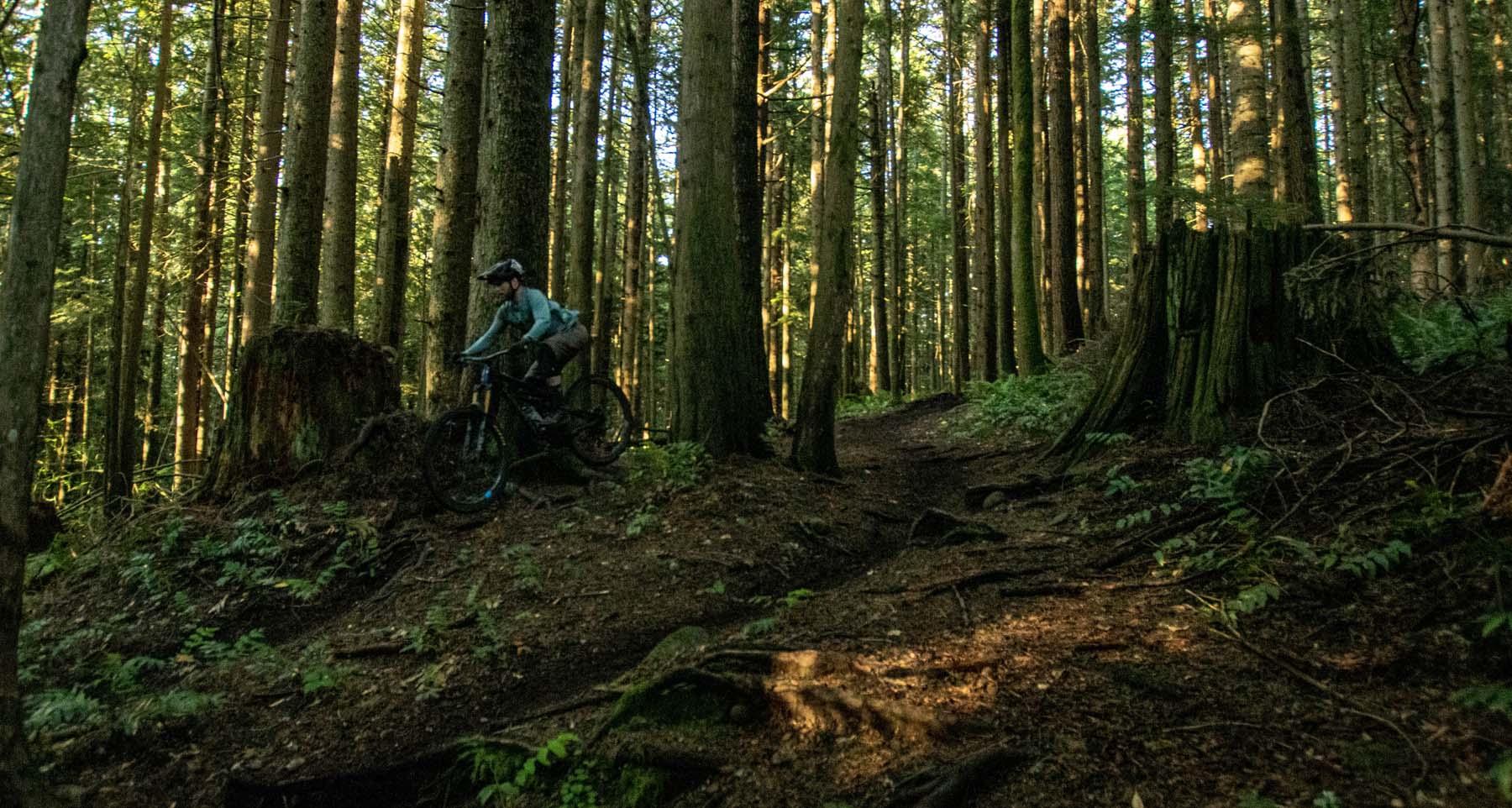
I think what Forge+Bond has done to move the 30 EM to the 32-hole rear wheel only, with the option for a 28- or 32-hole front (along with the addition of the new 30 AM wheel) makes a lot of sense. The 30 EMs are meant to be an option for heavier and/or more aggressive riders on Trail and Enduro bikes who want something on the burlier end of the spectrum; the 30 AM is now the wheel for people who’d favor a lighter, more compliant option. And given the smooth-riding, muted feel of the 30 EMs, we’re expecting similar things from the new 30 AMs — but will be finding out soon.
The 30 EMs have also held up nicely over the course of my testing. I haven’t needed to true them, the hubs are still spinning fine, and apart from some cosmetic scuffs and scrapes, the rims are still in great shape. Not much to report there. And while I’ve got no complaints with the Industry Nine Hydra hubs in our review wheels, it is nice to see a more affordable 1/1 build now being offered — 90 points of engagement are more than enough for me, and the weight difference is quite modest. The fancier Hydra build, with its 690 POE rear hub, is there if you want it, but I think most folks can comfortably save themselves the $300 price difference and go for the 1/1s.
Bottom Line
The Forge+Bond 30 EM wheels truly stand out as one of the smoother-riding, more muted-feeling carbon wheels out there. Especially for folks who’ve found other carbon wheels to feel too harsh and unforgiving, that could be quite compelling. Riders looking for the most precise-feeling wheels might be better off elsewhere (though we rode the 28-spoke versions of the 30 EMs, and the 32-spoke ones are presumably stiffer). But the 30 EMs genuinely do ride noticeably differently from a lot of other wheels out there and are likely to be just what certain riders are looking for.
We’ll also be testing the 30 EMs at Blister Labs to see just how they compare to a whole bunch of other wheels in a quantitative fashion — and learn more about what exactly makes them ride differently. Stay tuned for more to come soon.
